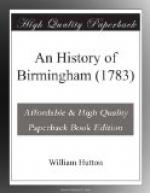In 1383, the sixth of Richard the Second, before the religious fervor subsided that had erected Deritend-chapel, Thomas de Sheldon, John Coleshill, John Goldsmith, and William att Slowe, all of Birmingham, obtained a patent from the crown to erect a building upon the spot where the Free School now stands in New-street, to be called The Gild of the Holy Cross; to endow it with lands in Birmingham and Edgbaston, of the annual value of twenty marks, for the maintenance of two priests, who were to perform divine service to the honor of God, our blessed Lady his Mother, the Holy Cross, St. Thomas, and St. Catharine.
The fashion seemed to take with the inhabitants, many of whom wished to join the four happy men, who had obtained the patent for so pious a work; so that, in 1393, a second patent was procured by the bailiff and inhabitants of Birmingham, for confirming the gild, and making the addition of a brotherhood in honor of the Holy Cross, consisting of both sexes, with power to constitute a master and wardens, and also to erect a chantry of priests to celebrate divine service in the chapel of the gild, for the souls of the founders, and all the fraternity; for whose support there were given, by divers persons, eighteen messuages, three tofts, (pieces of ground) six acres of land, and forty shillings rent, lying in Birmingham and Edgbaston aforesaid.
But, in the 27th of Henry the Eighth, 1536, when it was the fashion of that day, to multiply destruction against the religious, and their habitations, the annual income of the gild was valued, by the King’s random visitors, at the sum of 31_l_. 2s. 10d. out of which, three priests who sung mass, had 5_l_. 6s. 8d. each; an organist, 3_l_. 13s. 4d. the common midwife, 4s. the bell-man, 6s. 8d. with other salaries of inferior note.
These lands continued in the crown ’till 1552, the fifth of Edward the Sixth, when, at the humble suit of the inhabitants, they were assigned to
William Symmons, gent.
Richard Smallbrook,
bailiff of the town,
John Shilton,
William Colmore,
Henry Foxall,
William Bogee,
Thomas Cooper,
Richard Swifte,
Thomas Marshall,
John Veysy,
John King,
John Wylles,
William Paynton,
William Aschrig,
Robert Rastall,
Thomas Snowden,
John Eyliat,
William Colmore, jun.
AND
William Mychell,
all inhabitants of Birmingham, and their successors, to be chosen upon death or removal, by the appellation of the Bailiff and Governors of the Free Grammar School of King Edward the Sixth, for the instruction of children in grammar; to be held of the crown in common soccage, paying for ever twenty shillings per annum. Over this seminary of learning were to preside a master and usher, whose united income seems to have been only twenty pounds per annum. Both are of the clergy. The hall of the gild was used for a school-room. In the glass of the windows was painted the figure of Edmund Lord Ferrers; who, marrying, about 350 years ago, the heiress of the house of Birmingham, resided upon the manor, and seems to have been a benefactor to the gild, with his arms, empaling Belknap; and also, those of Stafford, of Grafton, of Birmingham, and Bryon.




